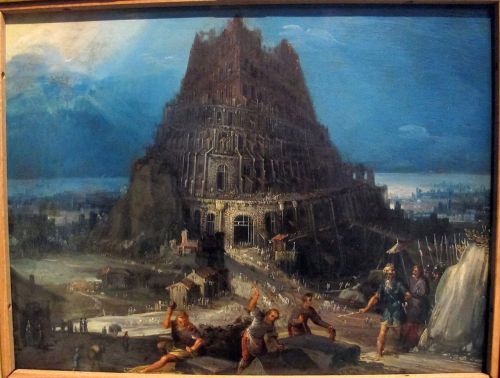Eco: The Illustrious Vernacular
by Estéban Trujillo de Gutiérrez

Lucas van Valckenborch (1535-97), Construction of the Tower of Babel, 1620 (I have no idea how this painting can be attributed to van Valckenborch, who died in 1597, while the painting is dated 1620). Held in the Musée d’Art et d’Histoire de Genève, photographed by Sailko, May 2014. This file is licensed under the Creative Commons Attribution 3.0 Unported license. This work is in the public domain in its country of origin and other countries and areas where the copyright term is the author’s life plus 100 years or less.
“Now we can begin to understand the nature of the illustre vernacular that Dante hunts like a perfumed panther (I, xvi, 1). We catch glimpses of it, evanescent, in the works of the poets that Dante considers the most important; but the language still remains unformed and unregulated, its grammatical principles unarticulated.
Confronted with the existing vernaculars, natural but not universal languages, and with a grammar that was universal but artificial, Dante sought to establish his dream of the restoration of the natural and universal forma locutionis of Eden.
Yet unlike those in the Renaissance who wished to restore the Hebrew language itself to its original magic and divinatory power, Dante’s goal was to reinstate these original conditions in a modern invention: an illustrious vernacular, of which his own poetry would constitute the most notable achievement, was, to Dante, the only way in which a modern poet might heal the wound of Babel.
The entire second part of DVE is therefore to be understood not as a mere treatise of style, but as an effort to fix the conditions, rules, forma locutionis of the only conceivable perfect language–the Italian of the poetry of Dante. (Corti 1981: 70).
The illustrious vernacular would take from the perfect language its necessity (as opposed to conventionality) because, just as the perfect forma locutionis permitted Adam to speak with God, so the illustrious vernacular would permit the poet to make his words adequate to express what he wished, and what could not be expressed otherwise.
Out of this bold conception for the restoration of a perfect language, and of his own role within it, comes a celebration of the quasi-biological force displayed by language’s capacity to change and renew itself over time instead of a lament over the multiplicity of tongues.
The assertion of language’s creativity, after all, stands at the base of Dante’s own project to create a perfect, modern, natural language, without recourse to a dead language as a model. For someone of Dante’s temperament, a conviction that the Hebrew of Adam was the one truly perfect language could only have resulted in the learning of Hebrew and in the composition of his poem in that idiom.
That Dante did not decide to learn Hebrew shows that he was convinced that the vernacular he intended to invent would correspond to the principles of the universal, God-given form better even than the Hebrew spoken by Adam himself.
Thus Dante puts forth his own candidacy as a new (and more perfect) Adam.”
Umberto Eco, The Search for the Perfect Language, translated by James Fentress, Blackwell. Oxford, 1995, pp. 45-6.
